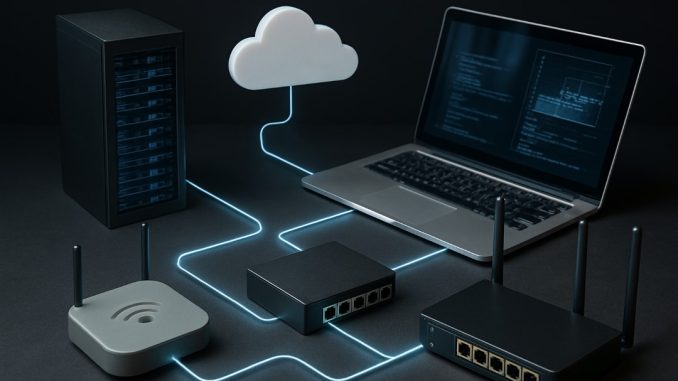
In today’s digital world, networking is at the heart of everything. From browsing the internet to sending a text message or streaming your favorite show. But how did it all begin? And what makes it work behind the scenes?
This guide takes you on a simple, easy-to-understand journey through the history of networking, from ancient communication methods to the modern internet. You’ll also learn about the common networking hardware — like routers, switches, and modems — that make it all possible.
Whether you’re an aspiring tech expert or just curious about how things connect, this guide is the perfect starting point.
History of Networking
Networking began centuries ago in ancient times, using drums, smoke signals, and human messengers. These early forms of communication were the first steps toward developing technology in human society.
Then came the Mechanical and Electrical Era, which marked the beginning of technological advancement. During this era, the telegraph was introduced in the 1800s — one of the first technologies used to send messages via electric signals over wires. Not long after, the telephone, invented by Alexander Graham Bell in 1876, revolutionized real-time voice communication. These inventions laid the foundation for the first electrical communication networks, used worldwide.
Next came the era of Early Computer Networking (1950s–1960s). Computers had been invented, but they were not yet connected to each other. Data had to be physically transferred using punch cards, tapes, or disks. To solve this limitation, scientists began searching for a way to connect computers so information could be shared automatically. This led to the creation of a system called packet switching, which breaks information into small parts (called packets) and sends them efficiently across a network.
The first packet-switching network was ARPANET, funded by the U.S. Department of Defense’s ARPA (Advanced Research Projects Agency). ARPANET became the foundation of the modern internet. After serving its purpose, ARPANET was officially decommissioned in 1990, making way for the next major development — the modern internet and the World Wide Web.
In this new era, a set of communication rules called the Transmission Control Protocol/Internet Protocol (TCP/IP) emerged in the 1980s, allowing computers to reliably communicate over networks. Then, in the 1990s, Tim Berners-Lee created the World Wide Web, which dramatically changed how people communicate, learn, shop, and share information. It made the internet accessible and useful to the general public.
Finally, we arrive at the Modern Networking Era. This era focuses on advanced systems and technologies that allow devices like smartphones, computers, smart TVs, and servers to communicate in real-time. This includes both wired and wireless connections, and supports a wide range of activities — from video calls and gaming to smart homes and cloud computing. Technologies like Wi-Fi, 5G, cloud services, and IoT (Internet of Things) are central to this period.
As networking evolved from ancient communication methods to the complex digital systems we rely on today, the need for physical tools to support these connections became essential. With each leap in technology—from the telegraph to the internet—came a new generation of devices designed to manage, direct, and maintain the flow of information. These hardware components serve as the backbone of modern networks, quietly powering the systems we use every day. To truly understand how networks function, it’s important to get familiar with the devices that make it all possible.
1. Hub – The Basic Distributor
A hub is the most basic form of networking hardware. It connects multiple devices in a network, but it doesn’t know who’s who. When it receives data from one device, it sends it to all connected devices—whether they need it or not.
“Think of it like shouting a message in a crowded room. Everybody hears it, but it might only be meant for one person.”
2. Access Point – The Wi-Fi Connector
An Access Point (AP) connects wireless devices to a wired network. It acts like a bridge between your phone or laptop and the internet, allowing wireless communication over Wi-Fi.
“If you’ve ever connected to a hotspot, you’ve used an access point—even if you didn’t know it.”
3. Router – The Network Boss
A router connects different networks and directs data between them. In most homes, the router connects your local devices to the internet. It makes decisions on where data should go based on IP addresses.
“Imagine a traffic officer directing cars at a busy junction—that’s what your router does for data.”
4. Patch Panel – The Cable Organizer
A patch panel is not a smart device, but it’s very important in places where there are a lot of network cables, like offices or server rooms. It helps organize and connect cables cleanly and efficiently.
“Think of it like a Power distribution board—but for internet cables.”
5. Power over Ethernet (PoE) – One Cable, Double Work
PoE allows a single Ethernet cable to carry both data and electrical power. This is especially useful for devices like IP cameras, VoIP phones, or wireless access points that may be far from power outlets.
“One cable, doing the work of two. Very useful in offices where cable management is key.”
Conclusion
At LinuxIT.io, we understand that the world of networking can seem overwhelming at first — but with the right guidance and foundational knowledge, anyone can master it. As proud partners with CompTIA, we’re committed to providing industry-recognized training and hands-on learning experiences for individuals looking to build a career in IT and networking. Whether you’re just starting out or aiming to sharpen your skills, understanding the basics of networking history and hardware is the first step toward becoming a confident tech professional. With LinuxIT.io by your side, your journey into the world of technology starts strong and stays future-ready.

Be the first to comment